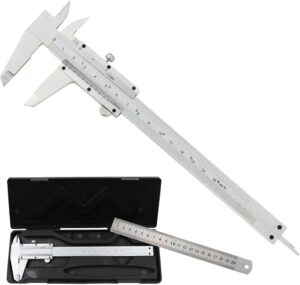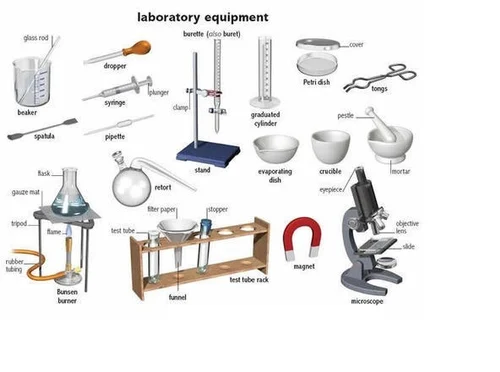School Science Laboratory Equipment List and Uses: A Comprehensive Guide
School Science laboratory Equipment list and uses In any educational setting, science laboratories serve as critical spaces where students can engage in hands-on learning, apply theoretical concepts, and foster a deeper understanding of scientific phenomena. The tools and equipment used in these labs are essential to this process, ensuring that students can carry out experiments safely and effectively. This article will provide a detailed list of school science laboratory equipment and explain their uses. It is designed for educators, students, and anyone interested in understanding the basic and advanced tools found in school science labs.
Science education is brought to life in a laboratory setting. Hands-on experiments not only make learning more engaging but also help students understand scientific concepts in depth. In a well-equipped science lab, students can conduct experiments, make observations, and apply theoretical knowledge in a practical setting. This article will explore essential laboratory equipment, explain their uses, and highlight how they contribute to a productive and safe learning environment.
In school science laboratories, both basic and advanced lab instruments are required for different subjects such as biology, chemistry, and physics. Using the right lab equipment ensures that students can safely carry out experiments and gather accurate results. Let’s look at some of the most essential tools you’ll find in a school science lab.
Why School Science Laboratories are Essential
Before diving into the list of equipment, it’s essential to understand the purpose of science labs in schools. Science education goes beyond textbooks. Students learn best when they can see, feel, and manipulate materials to test hypotheses and explore scientific principles. Labs provide a controlled environment where students can conduct experiments, make observations, and record their findings. Moreover, using laboratory equipment helps them develop problem-solving skills and fosters curiosity.
Basic School Science Laboratory Equipment List
1. Microscope
Use: The microscope is a fundamental tool in any biology or life sciences lab. It allows students to observe organisms, cells, and tissues that are too small to be seen with the naked eye. With its magnification capabilities, a microscope helps students explore the world at the microscopic level.
Transition: While microscopes are key to biology labs, chemistry and physics labs require other specialized tools.
2. Bunsen Burner
Use: A Bunsen burner is widely used in chemistry labs to heat substances. It produces a single open flame, which can be adjusted to provide different levels of heat. This equipment is essential for experiments that involve heating chemicals or liquids, such as when studying chemical reactions or properties of substances.
3. Test Tubes and Test Tube Racks
Use: Test tubes are small glass containers used to hold, mix, or heat chemical substances. They are crucial for conducting experiments on a small scale. Test tube racks are used to hold multiple test tubes simultaneously, keeping them organized during experiments.
4. Beakers
Use: Beakers are cylindrical glass containers used for mixing, heating, and stirring liquids. Their wide mouth allows for easy pouring and mixing, making them a staple in most scientific experiments.
5. Flasks (Erlenmeyer and Volumetric)
Use: Erlenmeyer flasks have a conical shape, making them ideal for mixing chemicals without the risk of spilling. Volumetric flasks, on the other hand, are used for making precise measurements of liquids. Both types of flasks are vital for experiments that involve chemical reactions or measuring substances.
Transition: Once the basics are in place, more specialized tools help enhance the learning experience further.
Specialized School Science Laboratory Equipment
6. Graduated Cylinders
Use: Graduated cylinders are used for accurately measuring the volume of liquids. They are more precise than beakers and flasks due to their narrow shape and marked graduations, making them essential for quantitative experiments.
7. Tongs and Forceps
Use: Tongs are used to hold or move hot glassware or equipment, ensuring safety during experiments that involve high temperatures. Forceps, on the other hand, are used for holding small objects that should not be touched by hand, such as chemicals or delicate specimens.
8. Pipettes and Droppers
Use: Pipettes and droppers are used to transfer small amounts of liquids from one container to another. Their precision makes them indispensable in biology, chemistry, and physics labs, especially when dealing with minute quantities of chemicals.
9. Thermometers
Use: Thermometers measure the temperature of liquids and substances during experiments. Both mercury and digital thermometers can be used, though digital thermometers are becoming more common due to safety concerns with mercury.
10. Balances (Analytical and Triple Beam)
Use: Balances are used to measure the mass of substances with precision. Analytical balances are more accurate and used for delicate measurements, while triple beam balances are sturdier and used for everyday weighing tasks.
Transition: After considering measurement and heating tools, let’s move to safety equipment, which ensures that the lab environment remains secure for all.
Safety Equipment in School Science Labs
11. Safety Goggles
Use: Safety goggles protect the eyes from chemical splashes, heat, and debris during experiments. They are perhaps the most important piece of safety equipment in any lab, especially during experiments involving corrosive chemicals or reactions that might produce harmful vapors.
12. Lab Coats and Gloves
Use: Lab coats protect clothing and skin from chemical spills, while gloves provide a barrier against hazardous substances. Both are necessary to ensure the safety of students and teachers when conducting experiments that involve chemicals, heat, or biological materials.
13. Fire Extinguisher
Use: In case of an accidental fire, a fire extinguisher is a must-have in any lab. Proper fire safety protocols should always be followed, and a fire extinguisher should be easily accessible.
14. First Aid Kit
Use: Accidents can happen in any lab setting, and a first aid kit is essential for providing immediate care. It typically contains bandages, antiseptic wipes, and burn ointments to treat minor injuries quickly.
15. Fume Hood
Use: A fume hood is used in experiments that release toxic fumes or vapors. It helps to ventilate hazardous gases out of the lab, ensuring that students and teachers are not exposed to harmful substances.
Transition: After ensuring the safety aspect, some labs are equipped with more advanced tools to extend learning.
Advanced Equipment in School Science Labs
16. Centrifuge
Use: A centrifuge is used to separate substances of different densities by spinning them at high speeds. It is especially useful in biology labs for separating cells, proteins, or DNA from liquids.
17. Spectrophotometer
Use: This device measures the absorbance or transmission of light by a liquid sample, allowing students to analyze the concentration of substances in solutions. It is commonly used in advanced chemistry and biology experiments.
18. pH Meter
Use: A pH meter is used to measure the acidity or alkalinity of a solution. While litmus paper can give a rough indication of pH, a pH meter provides a more accurate measurement, which is critical for experiments that require precise pH control.
19. Oscilloscope
Use: An oscilloscope is used in physics experiments to visualize electrical signals. It displays waveforms on a screen, making it possible to analyze the frequency, amplitude, and other properties of electrical currents.
20. Vernier Calipers
Known for their precision and quality, Vernier calipers are expertly manufactured by Hafiz Scientific Corporation, ensuring reliable tools for accurate measurements.
This smoothly connects the fact about the manufacturer with the broader context of precision and quality.
Use:Vernier calipers are utilized for the precise measurement of objects’ dimensions, such as length, depth, or diameter. The Vernier caliper was used to determine the thickness of the material. They are commonly applied in physics experiments where accurate measurements are deemed necessary.The Vernier caliper is manufactured by Hafiz Scientific Corporation.

Furthermore, alongside these specialized tools, several general-purpose pieces of equipment are recognized as critical in school science labs, ensuring the success of various experiments.
General Laboratory Tools and Their Uses
21. Glass Stirring Rods
Use: Glass stirring rods are used to mix chemicals and liquids in beakers or test tubes. Their glass composition ensures that they do not react with most chemicals, making them a reliable tool in most laboratory settings.
22. Wash Bottles
Use: Wash bottles are used to rinse equipment or add small amounts of distilled water to experiments. They are particularly helpful for cleaning glassware without contaminating it.
23. Mortar and Pestle
Use: The mortar and pestle are used to grind and crush solid substances into a fine powder, which can then be used in experiments. This tool is especially useful in chemistry labs when dealing with solid reactants.
24. Tripod and Wire Gauze
Use: A tripod stand is used to support glassware, such as beakers or flasks, during heating. Wire gauze is placed on top of the tripod to evenly distribute the heat from a Bunsen burner.
25. Funnel
Use: A funnel is used to transfer liquids or fine-grained substances into containers with small openings. It minimizes the risk of spills and is commonly used in experiments involving liquids. The funnel is manufactured by Hafiz Scientific Corporation.

Conclusion: The Importance of Using the Right Equipment
It has been made clear that the proper use of science laboratory equipment not only enhances learning but also ensures the safety of students and teachers. From the basic tools like microscopes and test tubes to more
advanced instruments like spectrophotometers and oscilloscopes, each piece of equipment plays a crucial role in facilitating experiments that enrich students’ understanding of scientific concepts.
Transition words and phrases were used throughout this article to ensure a smooth flow of information, making the content more readable and engaging for those seeking to learn about school science laboratory equipment.
As educational standards evolve, so too does the need for schools to equip their laboratories with the best tools available. This list, although comprehensive, serves as a foundation for building a well-equipped science lab that fosters curiosity, innovation, and safety in students.
By providing the right equipment and understanding their uses, educators can create an environment where students are free to explore, experiment, and learn in ways that will leave a lasting impact on their academic journey.

